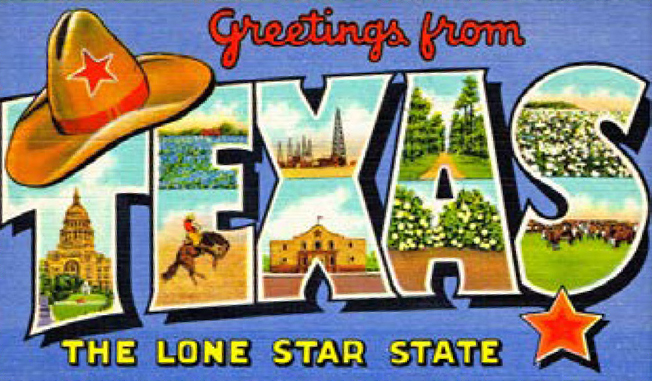By Peter Glaser
I had never heard of Grapevine, Texas, until my wife asked if I wanted to tag along to a conference she attended there last year. A suburban city situated between Dallas and Fort Worth, Grapevine was a revelation.
Settled in the 1840s and 1850s by a small group of pioneers, the initial attraction was land ownership in the area that offered rich soil and local springs—ingredients that yielded excellent harvests and future prosperity.  Taking its name from the wild mustang grapes so abundant in the region (not to mention the springs and prairie of the same name), the town began to thrive with the arrival of the Cotton Belt Railroad in 1888. Establishing itself as an agricultural trade center servicing the greater region, a formidable main street of dignified brick buildings emerged toward the end of the 19th and the first two decades of the 20th century.
Taking its name from the wild mustang grapes so abundant in the region (not to mention the springs and prairie of the same name), the town began to thrive with the arrival of the Cotton Belt Railroad in 1888. Establishing itself as an agricultural trade center servicing the greater region, a formidable main street of dignified brick buildings emerged toward the end of the 19th and the first two decades of the 20th century.
In the 1970s, with urbanization encroaching on a quaint prairie downtown, local historians stepped up to safeguard Grapevine’s wealth of heritage. In 1984, Grapevine became part of the Texas Main Street Program to preserve and revitalize its central thoroughfare. Moving forward, in 1991, the city adopted a historic preservation ordinance with the goal of protecting the city’s architectural heritage. In 1992, Grapevine’s downtown Main Street core was listed as a National Register Historic District.
Due to these efforts, Grapevine today has a charming thoroughfare, replete with restored, revitalized, and—in some cases—rebuilt (where losses had occurred) commercial structures.
1: Willhoite’s Restaurant

 How many restaurants can boast of having a 1927 Model T perched above a buffet station on an original hydraulic lift? Willhoite’s Restaurant can! Constructed in 1913, this building was initially a department store and then briefly a silent movie theater. In 1919, it was transformed into the Willhoite Garage, the first full-service automotive station in Grapevine. Named after co-owner Andrew Willhoite (Bart Starr was his partner in the enterprise), they ran the operation until 1936, when Willhoite’s son, Ted, took over the business. When Ted retired in 1975, the building was used as a furniture warehouse for five years, at which point it was purchased by Phil Parker and was renovated into Willhoite’s Restaurant and Galleria. The interior space was shared with retail shops on both the lower and upper levels until the restaurant’s success ultimately took over the entire building.
How many restaurants can boast of having a 1927 Model T perched above a buffet station on an original hydraulic lift? Willhoite’s Restaurant can! Constructed in 1913, this building was initially a department store and then briefly a silent movie theater. In 1919, it was transformed into the Willhoite Garage, the first full-service automotive station in Grapevine. Named after co-owner Andrew Willhoite (Bart Starr was his partner in the enterprise), they ran the operation until 1936, when Willhoite’s son, Ted, took over the business. When Ted retired in 1975, the building was used as a furniture warehouse for five years, at which point it was purchased by Phil Parker and was renovated into Willhoite’s Restaurant and Galleria. The interior space was shared with retail shops on both the lower and upper levels until the restaurant’s success ultimately took over the entire building.
Phil and his son, Eric, have been faithful to the structure’s history, preserving the name and restoring the building as authentically as possible. Many features of the auto shop’s past have been retained, including the exposed brick walls and original ceiling, a gas pump outside the front entrance, historical signs, and memorabilia—not to mention the Model T and hydraulic lift.
2: City Drug Store

The Texas General Store began as the Olympia Confectionary, which also played silent films in its early days. In 1914, C.E. “Pie” Stewart purchased the building and installed a soda fountain as an additional revenue source. Roy Chambers took over the business in the late 1940s, renaming it City Drug, the name of which is tastefully preserved in the exterior signage.
To read the rest of this article, members are invited to log in. Not a member? We invite you to join. This article originally appeared in SCA Road Notes, Fall 2025, Vol. 33, No. 3. SCA Road Notes, informally known as SCA News, is a quarterly publication and a member benefit of the Society for Commercial Archeology. Back issues are available for download.
More Articles Join the SCA


